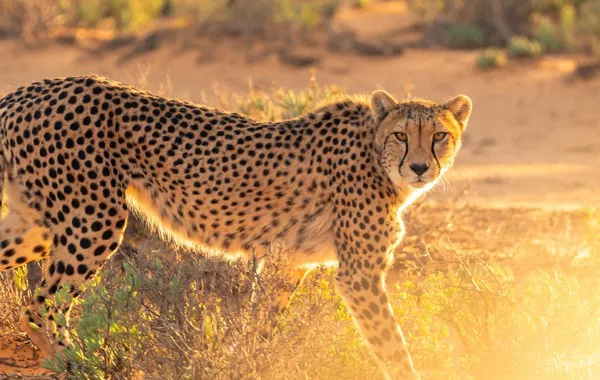In the vast and diverse world of wildlife, speed is often a crucial survival trait. From the savannas of Africa to the deserts of Australia, the animal kingdom boasts an array of fast-paced species adapted for life on land. This article delves into the exhilarating world of speed, unveiling the top 20 fastest animals on land. From graceful gazelles to sprinting cheetahs, each entry on this list highlights the remarkable adaptations that enable these creatures to navigate their environments with unmatched velocity.
Top 20 Fastest Animals on Land
1. Cheetah (Acinonyx jubatus):
Topping the list as the fastest land animal is the iconic cheetah. Renowned for its incredible acceleration and unmatched top speed, the cheetah can reach velocities of up to 75 miles per hour (120 km/h) in short bursts covering distances of around 500 meters. This remarkable speed is facilitated by the cheetah’s lightweight build, specialized muscles, and a unique non-retractable claw structure for traction.
2. Pronghorn (Antilocapra americana):
Native to North America, the pronghorn is the second-fastest land mammal, reaching speeds of up to 55 miles per hour (88 km/h). Evolving alongside now-extinct predators, the pronghorn’s exceptional speed is a testament to its ability to outpace threats on the open plains. These creatures possess a large windpipe and heart, enabling efficient oxygen delivery to muscles during rapid sprints.
3. Springbok (Antidorcas marsupialis):
Hailing from the grasslands of Southern Africa, the springbok is a medium-sized antelope celebrated for its incredible speed and agility. Capable of reaching speeds of around 50 miles per hour (80 km/h), springboks use their speed to evade predators and engage in territorial displays involving impressive leaps known as “pronking.”
4. Wildebeest (Connochaetes spp.):
Both the blue wildebeest and the black wildebeest, native to the grassy plains of Africa, are known for their robust build and remarkable speed. These herbivores can reach speeds of up to 50 miles per hour (80 km/h) when engaged in migratory movements or evading predators like lions and hyenas.
5. Lion (Panthera leo):
While not primarily known for their speed, lions can sprint at impressive speeds of around 50 miles per hour (80 km/h) for short distances. Lions use their speed to catch prey during coordinated hunts, showcasing the versatility of these apex predators in the African savanna.
6. Blackbuck (Antilope cervicapra):
Native to the Indian subcontinent, the blackbuck is a slender and elegant antelope renowned for its speed. Capable of reaching speeds up to 50 miles per hour (80 km/h), blackbucks employ their agility to escape predators and navigate the open grasslands that constitute their natural habitat.
7. Thomson’s Gazelle (Eudorcas thomsonii):
Found in large numbers across the East African plains, Thomson’s gazelle is a graceful and agile herbivore capable of reaching speeds of approximately 50 miles per hour (80 km/h). Their speed and maneuverability make them challenging targets for predators such as cheetahs and leopards.
8. Quarter Horse (Equus ferus caballus):
Among domesticated animals, the Quarter Horse stands out as one of the fastest. Known for its sprinting ability, the Quarter Horse can attain speeds of around 47 miles per hour (76 km/h). These horses are often used in short-distance racing and various equine sports, showcasing their impressive acceleration.
9. Coyote (Canis latrans):
Native to North America, the coyote is a highly adaptable and intelligent predator capable of reaching speeds of up to 43 miles per hour (69 km/h). This speed, combined with their keen senses, makes coyotes effective hunters, enabling them to pursue prey across a variety of landscapes.
10. Greyhound (Canis lupus familiaris):
Known for their exceptional speed and sleek physique, Greyhounds are a domesticated breed of dog often used in racing. These canines can reach speeds of around 45 miles per hour (72 km/h), making them one of the fastest dog breeds and popular contenders in competitive racing events.
11. Ostrich (Struthio camelus):
The ostrich is the largest bird in the world, and despite its flightless nature, it is an extraordinary runner. Native to Africa, ostriches can reach speeds of up to 45 miles per hour (72 km/h), using their powerful legs to cover large distances while escaping from predators.
12. Kangaroo (Macropus spp.):
Australia’s iconic marsupials, kangaroos, are well-known for their hopping locomotion. The red kangaroo, the largest marsupial, can reach speeds of around 40 miles per hour (64 km/h). Their powerful hind legs, adapted for hopping, allow them to cover vast distances efficiently.
13. Grant’s Gazelle (Nanger granti):
Native to East Africa, Grant’s gazelle is a large and slender antelope known for its impressive speed. Capable of reaching speeds of approximately 40 miles per hour (64 km/h), these herbivores use their agility to evade predators and thrive in the savanna landscapes they call home.
14. Horse (Equus ferus caballus):
The domesticated horse, a crucial companion in human history, is renowned for its speed and strength. Horses can reach speeds of up to 40 miles per hour (64 km/h), showcasing their versatility in various equestrian sports and historical roles in transportation and warfare.
15. Zebra (Equus spp.):
Zebras, native to Africa, are known for their distinctive black and white stripes. While they may not match the speed of some predators, zebras can reach speeds of around 40 miles per hour (64 km/h) when evading threats. Their ability to change direction rapidly is a key survival strategy.
16. Antelope (Various species):
Various antelope species, including the gemsbok and impala, are renowned for their speed and agility. These herbivores can reach speeds ranging from 35 to 40 miles per hour (56 to 64 km/h), enabling them to navigate the vast landscapes of Africa and evade their natural predators.
17. Coywolf (Canis latrans × Canis lupus):
A hybrid between coyotes and wolves, the coywolf exhibits a blend of characteristics from both parent species. Known for its adaptability and intelligence, the coywolf can reach speeds of up to 35 miles per hour (56 km/h), showcasing the agility inherited from its coyote ancestors.
18. Domestic Cat (Felis catus):
While house cats may not compete with larger predators in terms of top speed, they are agile hunters and can reach speeds of around 30 miles per hour (48 km/h). Domestic cats often use their speed and agility to stalk and catch prey, displaying their natural instincts.
19. Hare (Various species):
Hares, known for their powerful hind legs and swift movements, can reach speeds of up to 35 miles per hour (56 km/h). Their speed is a crucial adaptation for evading predators, and hares often engage in zigzagging patterns to escape pursuers.
20. Red Fox (Vulpes vulpes):
The red fox, a highly adaptable and widespread carnivore, can reach speeds of around 30 miles per hour (48 km/h). Foxes use their speed and agility for hunting small mammals, birds, and insects, showcasing their ability to thrive in diverse environments.
See Also: 10 FASTEST ANIMALS ON EARTH
Conclusion:
From the lightning-fast cheetahs of the African savanna to the agile springboks and pronghorns of open plains, the world is home to a diverse array of land animals that have evolved to harness the power of speed for survival. Each species on this list brings unique adaptations and characteristics that contribute to their remarkable ability to traverse landscapes with unmatched velocity. As we continue to explore the wonders of the animal kingdom, the quest to understand the intricacies of speed in the wild unveils the captivating stories of evolution and adaptation that have shaped these incredible creatures.
You Might Be Interested In:

























